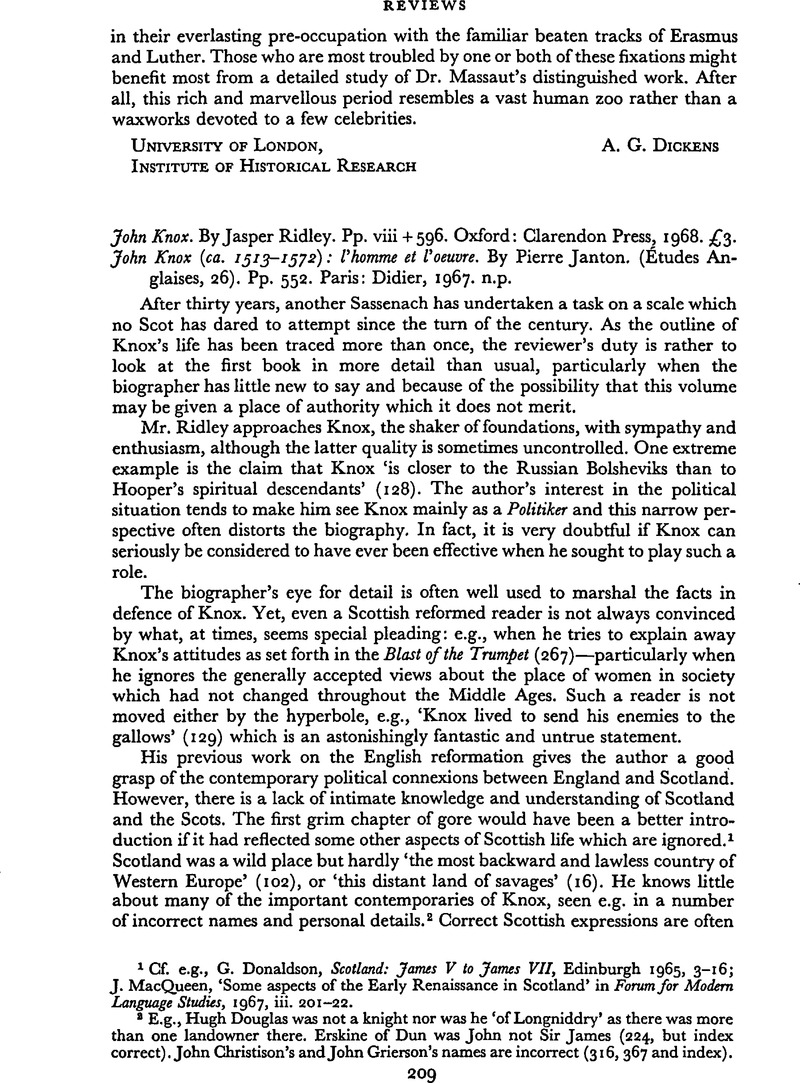No CrossRef data available.
Published online by Cambridge University Press: 25 March 2011

page 209 note 1 Cf. e.g., Donaldson, G., Scotland: James V to James VII, Edinburgh 1965, 3–16Google Scholar; MacQueen, J., ‘Some aspects of the Early Renaissance in Scotland’ in Forum for Modern Language Studies, 1967, III. 201–22.Google Scholar
page 209 note 2 E.g., Hugh Douglas was not a knight nor was he ‘of Longniddry’ as there was more than one landowner there. Erskine of Dun was John not Sir James (224, but index correct). John Christison's and John Grierson's names are incorrect (316, 367 and index). Sir Richard Maitland was not so old in 1546 (42)—he did not die until 1586—and it is doubtful if he was a papist when Knox wrote his History (42). William Harlaw was not a chaplain to Edward VI (223). John Black, O.P. was not just ‘one of Mary's Catholic friars’ (446 f.): he was her confessor and had been a teacher at the university of St. Andrews prior to 1560. John Willock was the author of ‘Letter of a Man banished out of Leicestershire’ not Gilbie (198). Matthew Stewart, fourth Earl of Lennox, and his son Henry Stewart, Lord Darnley, were not leaders of English and Scottish Roman Catholics but Lennox was an exile because of his attachment to the Protestant and pro-English cause. There is no evidence that Darnley was a Roman Catholic when he married Mary, Queen of Scots.
page 210 note 1 E.g., ‘Civil Assize Court’ (300) would never be used. Commendator is the correct designation of Gavin Hamilton (403, 488), Malcolm Fleming (422), and William Ker (4O7n.) and the last could hardly be described as a ‘Catholic religious man’. Kirk session is the correct description, never ‘Church Session’ (passim.) It seems doubtful if the difference between £ Scots and £ Sterling is understood (518).
page 210 note 2 E.g., there were no monasteries in Linlithgow (332), Lindores had no connexion with the Dominican Order, there was an abbey of the order of Tiron (327) and St. Giles, Edinburgh was not a cathedral in the sixteenth century (333).
page 210 note 3 Chapter xxi.
page 210 note 4 Cf. G. W. Locher, ‘Grundzüge der Theologie Huldrych Zwinglis im Vergleich mit derjenegen Martin Luthers und Johannes Calvin’, in Zwingliana, xii. 476–9 and 582–90.
page 210 note 5 Benoit, J-D., ‘Calvin et le baptême des enfants’, in Revue d'Histoire et de Philosophie religieuses, XVII (1937), 357–473.Google Scholar
page 211 note 1 Reprinted in F. Hortleder, Handlungen und Ausschreiben … von Rechtmässigkeit des Teutschen Kriegs Karls des Fünfften, Gotha 1615, IV. vii.
page 211 note 2 Cf. Shaw, D., The General Assemblies of the Church of Scotland 1560–1600. Edinburgh 1964, 31n.Google Scholar
page 211 note 3 Dickinson, W. C., Andrew Lang, John Knox and Scottish Presbyterianism, Edinburgh 1952, 12.Google Scholar
page 211 note 4 Anderson, W. J., ‘John Knox at Dieppe’ in The Innes Review, Glasgow 1962, XIII. 104.Google Scholar